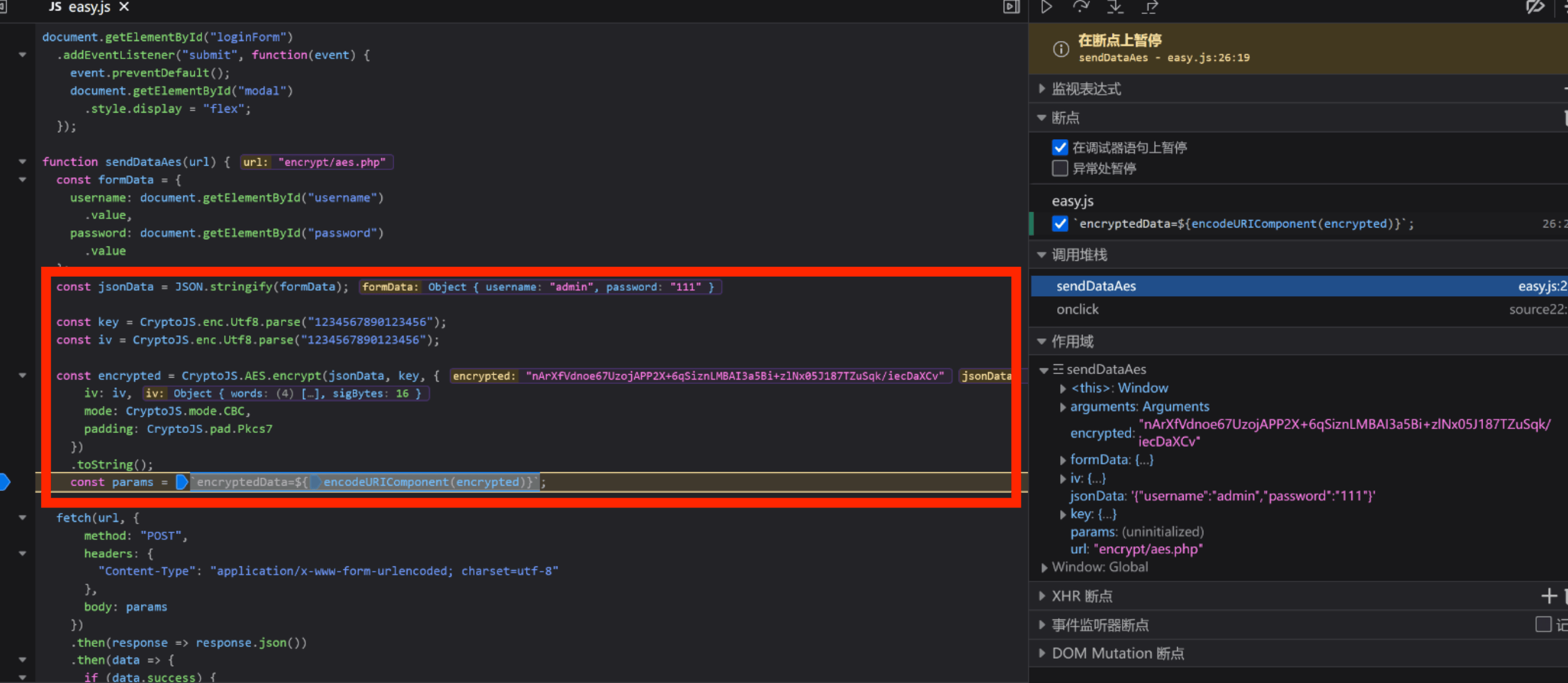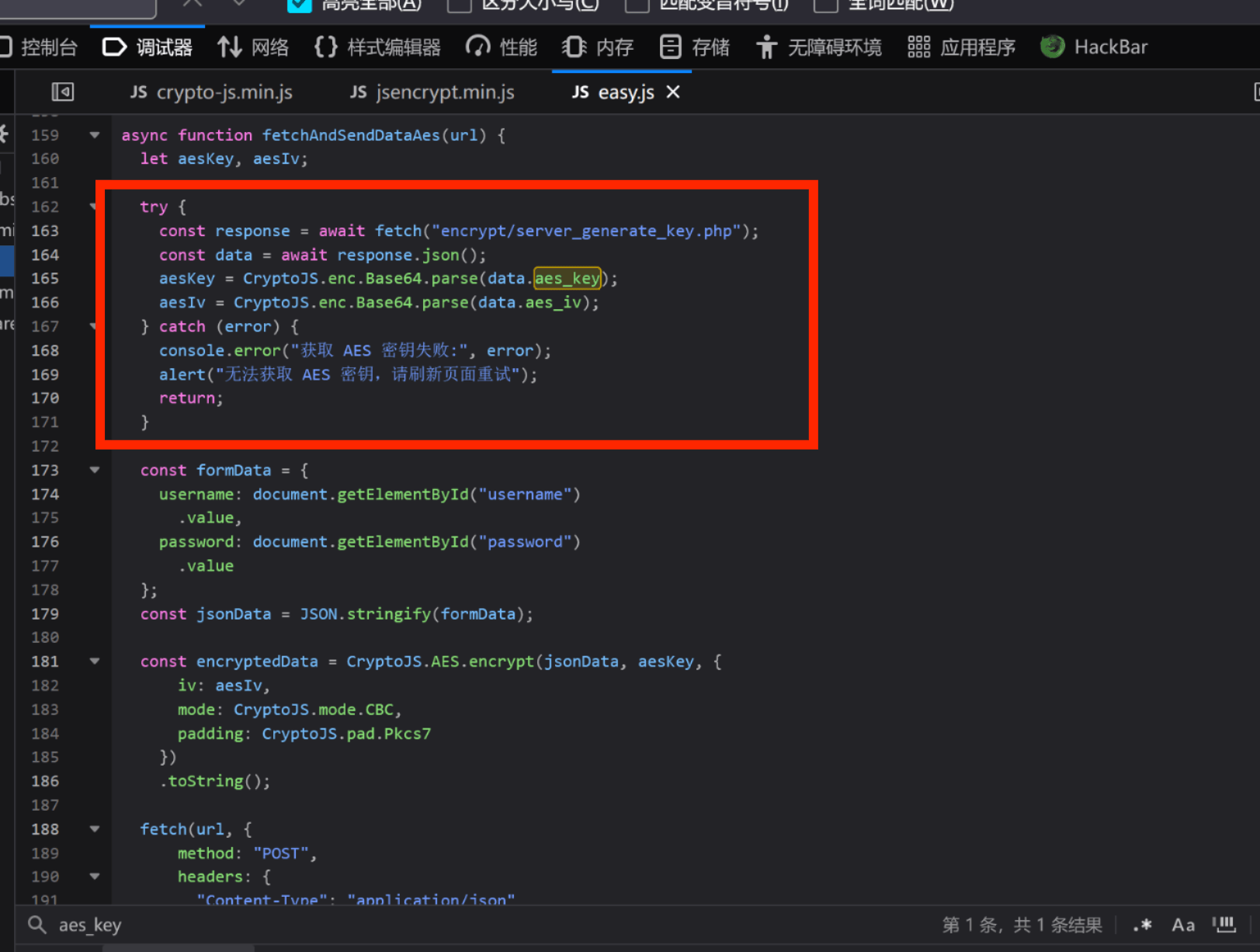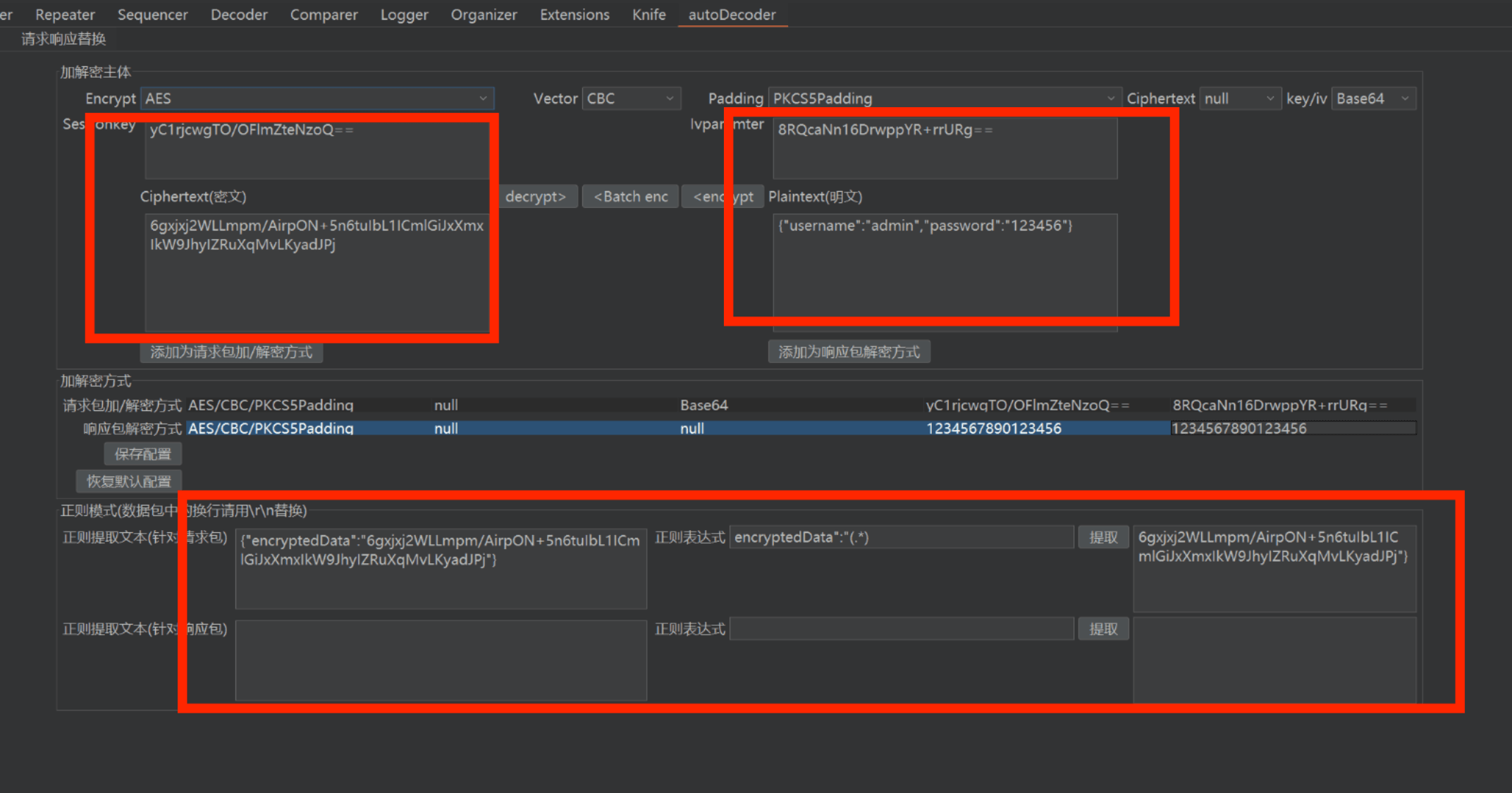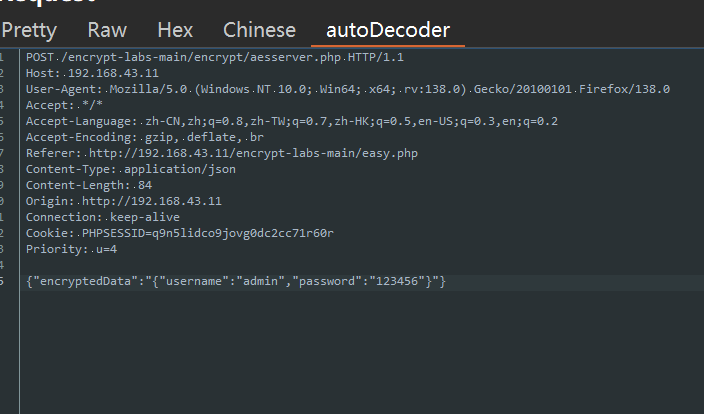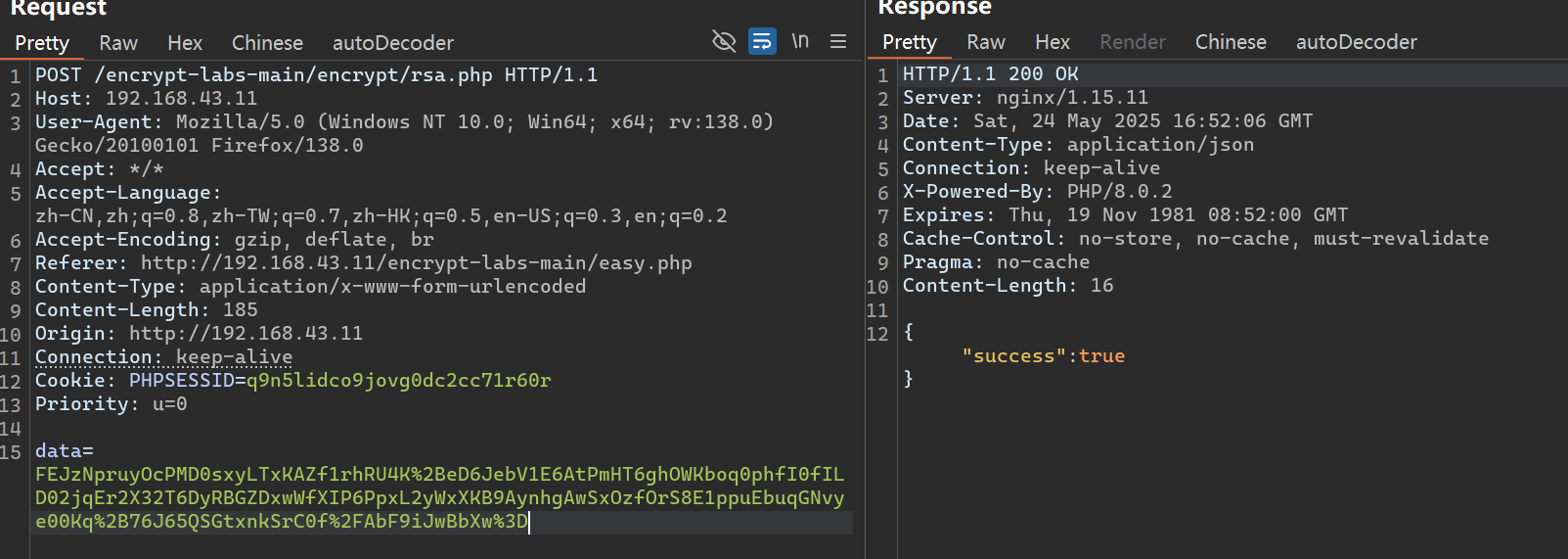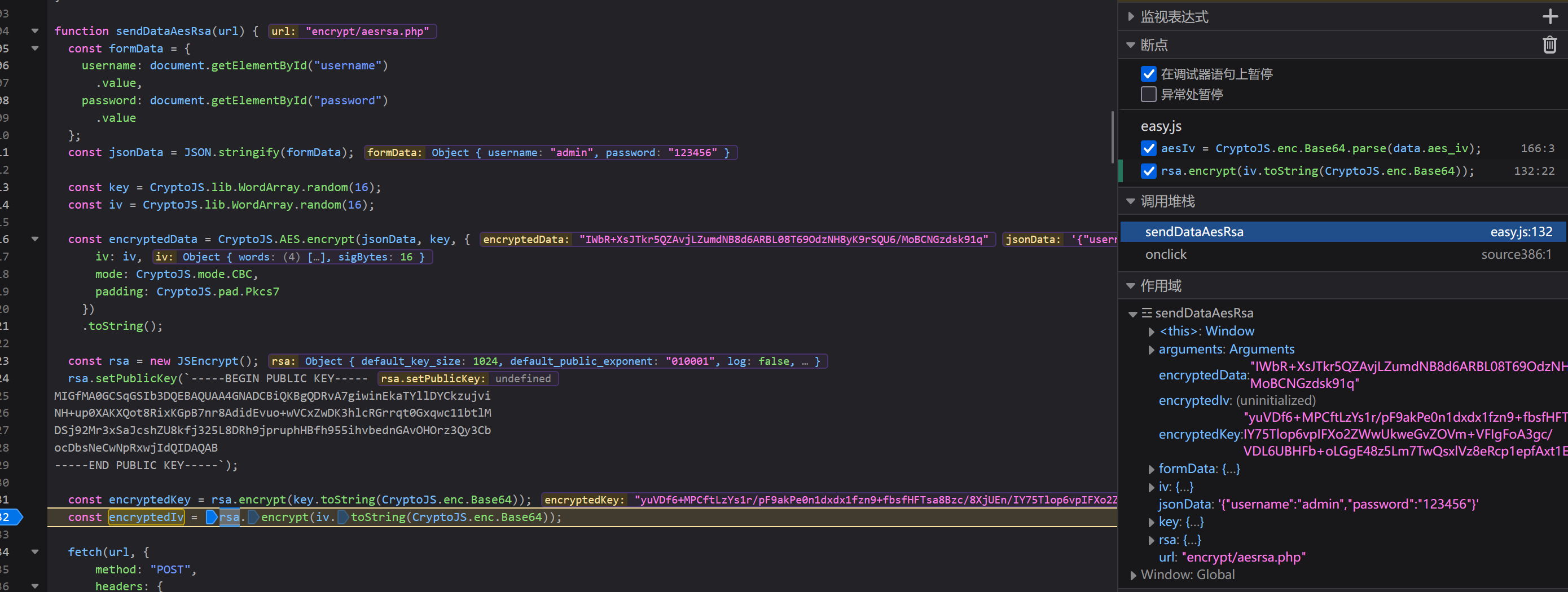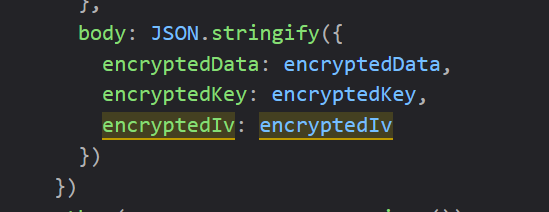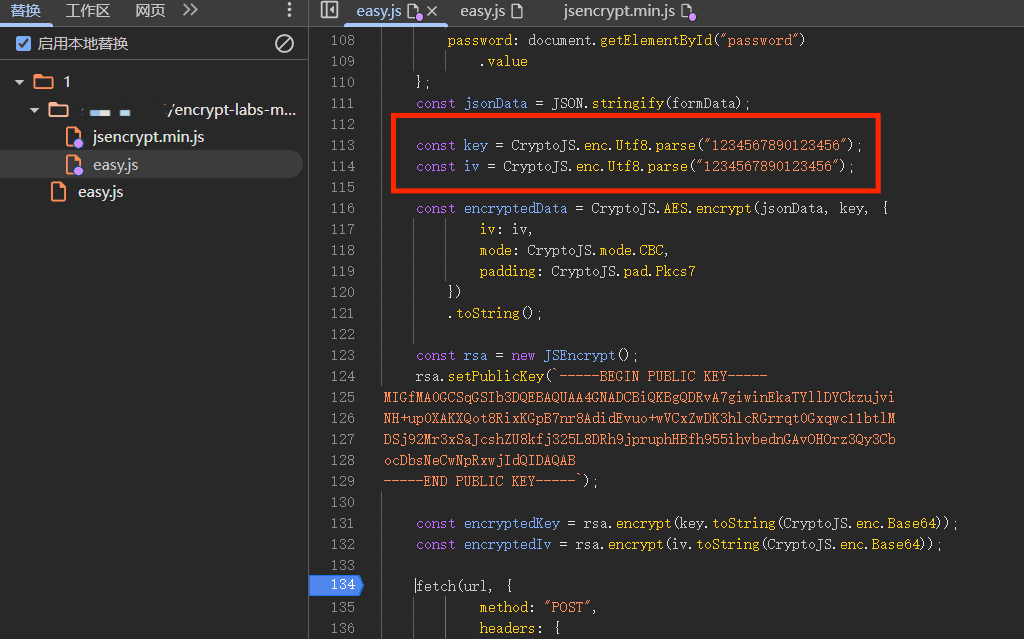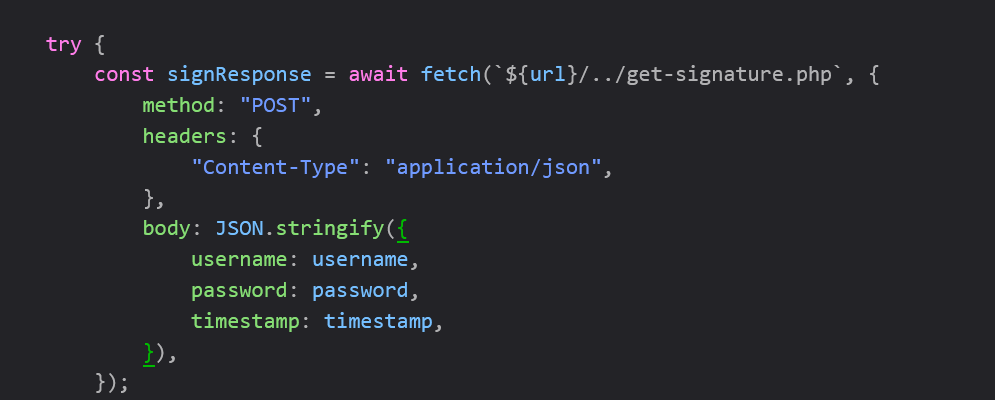本文最后更新于 2025年5月27日 晚上
前言 学长推荐的一个靶场,对于 js 这一块还没接触过,所以来打打,感觉还是挺不错的
项目地址:https://github.com/SwagXz/encrypt-labs
作者:SwagXz
burp 自动加解密插件 autoDeceder:https://github.com/f0ng/autoDecoder (有时候会有点小问题)
浏览器插件:https://ctool.dev/
AES 固定 key 乱输,然后抓包
发现了 encryptedData 加密参数
1 2 3 {"encryptedData" : "nArXfVdnoe67UzojAPP2X+6qSiznLMBAI3a5Bi+zlNx05J187TZuSqk/iecDaXCv"
查看 js 代码搜索关键字找到了 aes 加密代码,CBC 模式的 AES 加密,下断点执行,有固定的 key 和 iv,可以直接还原明文
key 和 iv
1 2 const key = CryptoJS .enc .Utf8 .parse ("1234567890123456" );const iv = CryptoJS .enc .Utf8 .parse ("1234567890123456" );
明文数据
1 { "username" : "admin" , "password" : "111" }
AES 服务端获取 Key 起了两个请求,分别获取 aes_key 和 aes_iv,然后利用算法对数据进行加密传输
1 { "aes_key" : "yC1rjcwgTO\/OFlmZteNzoQ==" , "aes_iv" : "8RQcaNn16DrwppYR+rrURg==" }
搜索关键字定位到算法部分,发现服务器请求获取 key 和 iv ,重发数据包发现 key 和 iv 短时间内不会发生变化
autoDecoder 配置
解密成功
RSA 加密 抓包拿到数据,出现 data 参数
搜索关键字,找到加密代码,打个断点调试
拿到数据,只有公钥,没有私钥,只能加密
1 2 3 4 5 6 -----BEGIN PUBLIC KEY -----MIGfMA 0GCSqGSIb3DQEBAQUAA4GNADCBiQKBgQDRvA7giwinEkaTYllDYCkzujviNH +up0XAKXQot8RixKGpB7nr8AdidEvuo+wVCxZwDK3hlcRGrrqt0Gxqwc11btlMDSj92Mr3 xSaJcshZU8kfj325L8DRh9jpruphHBfh955ihvbednGAvOHOrz3Qy3CbEND PUBLIC KEY -----
autoDecoder 配置
AES + RSA 加密 抓包看数据
搜索关键参数查找加密算法,下断点获取数据
1 2 3 4 5 6 7 8 9 10 11 12 13 14 15 16 17 18 19 20 21 22 23 24 25 26 27 28 29 function sendDataAesRsa (url ) {const formData = {username : document .getElementById ("username" )value ,password : document .getElementById ("password" )value const jsonData = JSON .stringify (formData);const key = CryptoJS .lib .WordArray .random (16 );const iv = CryptoJS .lib .WordArray .random (16 );const encryptedData = CryptoJS .AES .encrypt (jsonData, key, {iv : iv,mode : CryptoJS .mode .CBC ,padding : CryptoJS .pad .Pkcs7 toString ();const rsa = new JSEncrypt ();setPublicKey (`-----BEGIN PUBLIC KEY----- MIGfMA0GCSqGSIb3DQEBAQUAA4GNADCBiQKBgQDRvA7giwinEkaTYllDYCkzujvi NH+up0XAKXQot8RixKGpB7nr8AdidEvuo+wVCxZwDK3hlcRGrrqt0Gxqwc11btlM DSj92Mr3xSaJcshZU8kfj325L8DRh9jpruphHBfh955ihvbednGAvOHOrz3Qy3Cb ocDbsNeCwNpRxwjIdQIDAQAB -----END PUBLIC KEY-----` );const encryptedKey = rsa.encrypt (key.toString (CryptoJS .enc .Base64 ));const encryptedIv = rsa.encrypt (iv.toString (CryptoJS .enc .Base64 ));
被加密的参数是 formData 也就是 "{"username":"admin","password":"123456"}"
经过 AES 加密,但加密使用的 key 和 iv 是16位随机数,得到 encryptedData,然后对 key 和 iv 进行 rsa 加密得到encryptedKey 和 encryptedIv,再将这三个参数传入数据包中发包进行验证
将随机 16 位的 key 和 iv 进行固定,右键选择替换内容,使用本地替换的方式固定 key 和 iv
1 2 const key = CryptoJS .enc .Utf8 .parse ("1234567890123456" );const iv = CryptoJS .enc .Utf8 .parse ("1234567890123456" );
右键浏览器(从 Firefox 换成了 Chrome)替换,选择本地替换,新建一个 js 文件替换
下断点调试
经过几次登录发现 encryptedData 不会变,但 Key 和 Iv 会改变,说明修改成功了
autoDecoder 配置和之前一样,解密成功
Des 规律 Key 抓包拿到数据,只对 password 进行了加密
1 { "username" : "admin" , "password" : "3981f487c5afde43" }
加密算法比较简单
1 2 3 4 5 6 7 8 9 10 11 12 13 14 15 16 17 18 19 function encryptAndSendDataDES (url ) {const username = document .getElementById ("username" )value ;const password = document .getElementById ("password" )value ;const key = CryptoJS .enc .Utf8 .parse (username.slice (0 , 8 )padEnd (8 , '6' ));const iv = CryptoJS .enc .Utf8 .parse ('9999' + username.slice (0 , 4 )padEnd (4 , '9' ));const encryptedPassword = CryptoJS .DES .encrypt (password, key, {iv : iv,mode : CryptoJS .mode .CBC ,padding : CryptoJS .pad .Pkcs7 const encryptedHex = encryptedPassword.ciphertext .toString (CryptoJS .enc .Hex );
简单的 DES 加密,key 和 iv 都使用了username 的值,key 是 8 位,如果 username 不满 8 位则用 6 补满,iv 是 8 位,9999 + username 的前四位,所以输入 admin,key 和 iv 值如下:
1 2 key:admin666
autoDecoder 解密
明文加签 抓包拿到数据,多了两个参数分别是 nonce,signature ,还有个时间戳
1 { "username" : "admin" , "password" : "123456" , "nonce" : "r4nauns4od" , "timestamp" : 1748175966 , "signature" : "9ffc131e7a68507c6338362ff38e1450ab12ccf22fc97d439115462566047ba7" }
加密算法
1 2 3 4 5 6 7 8 9 10 11 12 13 14 15 function sendDataWithNonce (url ) {const username = document .getElementById ("username" )value ;const password = document .getElementById ("password" )value ;const nonce = Math .random ()toString (36 )substring (2 );const timestamp = Math .floor (Date .now () / 1000 );const secretKey = "be56e057f20f883e" ;const dataToSign = username + password + nonce + timestamp;const signature = CryptoJS .HmacSHA256 (dataToSign, secretKey).toString (CryptoJS .enc .Hex );
nonce:小写字母和数字组成的随机字符串
dataToSign:username + password + nonce + timestamp
signature:由 dataToSign 经过 SHA256 加密生成,secretKey为固定值 be56e057f20f883e
使用了 HmacSHA256 对 username、password、nonce、timestamp 进行了签名校验,但是拿到了 Key,所以可以伪造签名
1 2 3 4 5 6 7 8 9 10 11 12 13 14 15 16 17 18 19 20 21 22 23 24 25 26 27 28 29 30 31 32 33 34 35 36 37 38 39 40 41 42 43 44 45 46 47 48 49 50 51 52 53 import timeimport hmacimport hashlibimport requestsimport randomimport pprint"http://172.22.9.123/encrypt-labs-main/encrypt/signdata.php" "be56e057f20f883e" "admin" "123456" def generate_nonce ():return '' .join(random.choice('0123456789abcdefghijklmnopqrstuvwxyz' ) for _ in range (16 ))def generate_signature (username, password, nonce, timestamp, key ):str (timestamp)return hmac.new(key.encode('utf-8' ), data_to_sign.encode('utf-8' ), hashlib.sha256).hexdigest()def send_signed_request ():int (time.time())"Host" : "172.22.9.123" ,"User-Agent" : "Mozilla/5.0 (Windows NT 10.0; Win64; x64; rv:138.0) Gecko/20100101 Firefox/138.0" ,"Content-Type" : "application/json" ,"Accept" : "*/*" ,"Origin" : "http://172.22.9.123" ,"Referer" : "http://172.22.9.123/encrypt-labs-main/easy.php" ,"username" : username,"password" : password,"nonce" : nonce,"timestamp" : timestamp,"signature" : signatureprint ("Status Code:" , response.status_code)print ("Response Headers:" )dict (response.headers))if __name__ == "__main__" :
运行拿到结果
加签 key 在服务端 抓包返回了两个页面数据
第一个数据包获取 signature
第二个数据包加上获取的 signature
查看加密算法,发现先去服务端获取签名,然后对username,password,timestamp 进行签名再登录
因为加解密都在服务器端完成所以无法伪造
禁止重放 抓包,发现账号密码是明文的,多了一个 random 参数
定位算法调试
1 2 3 4 5 6 7 8 9 10 11 12 13 14 15 16 17 18 19 20 21 22 23 24 25 26 27 28 29 30 31 32 33 34 35 36 37 38 39 40 41 42 43 function generateRequestData (const username = document .getElementById ("username" ).value ;const password = document .getElementById ("password" ).value ;const timestamp = Date .now ();const publicKey = `-----BEGIN PUBLIC KEY----- MIGfMA0GCSqGSIb3DQEBAQUAA4GNADCBiQKBgQDRvA7giwinEkaTYllDYCkzujvi NH+up0XAKXQot8RixKGpB7nr8AdidEvuo+wVCxZwDK3hlcRGrrqt0Gxqwc11btlM DSj92Mr3xSaJcshZU8kfj325L8DRh9jpruphHBfh955ihvbednGAvOHOrz3Qy3Cb ocDbsNeCwNpRxwjIdQIDAQAB -----END PUBLIC KEY-----` ;function rsaEncrypt (data, publicKey ) {const jsEncrypt = new JSEncrypt (); setPublicKey (publicKey);const encrypted = jsEncrypt.encrypt (data.toString ());if (!encrypted) {throw new Error ("RSA encryption failed." );return encrypted;let encryptedTimestamp;try {rsaEncrypt (timestamp, publicKey);catch (error) {console .error ("Encryption error:" , error);return null ;const dataToSend = {username : username,password : password,random : encryptedTimestamp return dataToSend;function sendLoginRequest (url ) {const dataToSend = generateRequestData ();
通过算法可以知道 random 是通过 encryptedTimestamp 来的,encryptedTimestamp 是通过时间戳经过 RSA 加密来的
防止请求被重放,同样写脚本
1 2 3 4 5 6 7 8 9 10 11 12 13 14 15 16 17 18 19 20 21 22 23 24 25 26 27 28 29 30 31 32 33 34 35 36 37 38 39 40 41 42 43 44 45 46 47 48 49 50 import timeimport jsonimport requestsfrom base64 import b64encodefrom Crypto.PublicKey import RSAfrom Crypto.Cipher import PKCS1_v1_5import pprint"http://172.22.9.123/encrypt-labs-main/encrypt/norepeater.php" """-----BEGIN PUBLIC KEY----- MIGfMA0GCSqGSIb3DQEBAQUAA4GNADCBiQKBgQDRvA7giwinEkaTYllDYCkzujvi NH+up0XAKXQot8RixKGpB7nr8AdidEvuo+wVCxZwDK3hlcRGrrqt0Gxqwc11btlM DSj92Mr3xSaJcshZU8kfj325L8DRh9jpruphHBfh955ihvbednGAvOHOrz3Qy3Cb ocDbsNeCwNpRxwjIdQIDAQAB -----END PUBLIC KEY-----""" def rsa_encrypt (data, public_key ):'utf-8' ))return b64encode(encrypted_data).decode('utf-8' )def send_request ():str (int (time.time() * 1000 ))"Host" : "172.22.9.123" ,"User-Agent" : "Mozilla/5.0 (Windows NT 10.0; Win64; x64; rv:138.0) Gecko/20100101 Firefox/138.0" ,"Content-Type" : "application/json" ,"Accept" : "*/*" ,"Cookie" : "PHPSESSID=snuhsl9mkun6ftjd3481d3g5nd" ,"Origin" : "http://172.22.9.123" ,"Referer" : "http://172.22.9.123/encrypt-labs-main/easy.php" ,"username" : "admin" ,"password" : "123456" ,"random" : encrypted_tsprint ("Status Code:" , response.status_code)print ("Response Headers:" )dict (response.headers))print ("Response Body:" )print (response.text)if __name__ == "__main__" :5 )
成功


